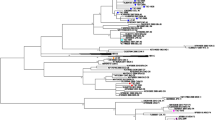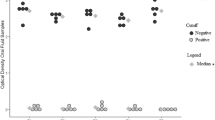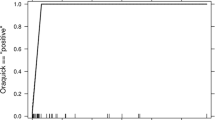Abstract
Little is known about the usefulness of saliva samples for hepatitis B virus (HBV) genotyping and mutation analysis. The aim of this study was to evaluate the usefulness of oral fluid samples to determine HBV genotype distribution, S/polymerase mutations, and HBV subpopulation diversity among chronically HBV-infected individuals. Serum and oral fluid samples were obtained from 18 individuals for PCR and nucleotide sequencing of the HBV surface antigen gene. Biochemical analysis of liver enzymes (ALT, AST, GGT) and HBV, HCV, and HIV serological tests were also performed. All serum samples were HBsAg (+), anti-HBc (+), and anti-HBs (−); 55.6% were HBeAg (+)/anti-HBe (−), and 11.1% were anti-HIV (+). The mean HBV DNA viral load was 6.1 ± 2.3 log IU/mL. The HBV genotype distribution was as follows: A, 72.2%; D, 11.1%; E, 5.6%; F, 11.1%. A concordance of 100% in genotype classification and 99.8% in sequence similarity between paired oral fluid and serum samples was observed. HBsAg mutations were detected in all samples, but no resistance mutations were found in the polymerase gene. This study demonstrates that oral fluid samples can be used reliably for tracking HBV mutations, genotyping, and phylogenetic analysis. This could be important for molecular epidemiology studies with hard-to-reach populations.

Similar content being viewed by others
Availability of data and material
The datasets generated and/or analysed during the current study are not publicly available, in order to maintain the privacy and confidentiality of the subjects, but are available from the corresponding author upon reasonable request.
References
Kramvis A (2014) Genotypes and genetic variability of hepatitis B virus. Intervirology 57:141–150. https://doi.org/10.1159/000360947
Tong S, Revill P (2016) Overview of hepatitis B viral replication and genetic variability. J Hepatol 64:S4–S16. https://doi.org/10.1016/j.jhep.2016.01.027
Arauz-Ruiz P, Norder H, Robertson BH, Magnius LO (2002) Genotype H: a new Amerindian genotype of hepatitis B virus revealed in Central America. J Gen Virol 83:2059–2073. https://doi.org/10.1099/0022-1317-83-8-2582059
Norder H, Courouce AM, Coursaget P, Echevarria JM, Lee SD, Mushahwar IK, Robertson BH, Locarnini S, Magnius LO (2004) Genetic diversity of hepatitis B virus strains derived worldwide: genotypes, subgenotypes, and HBsAg subtypes. Intervirology 47:289–309. https://doi.org/10.1159/000080872
Tran TT, Trinh TN, Abe K (2008) New complex recombinant genotype of hepatitis B virus identified in Vietnam. J Virol 82:5657–5663. https://doi.org/10.1128/JVI.02556-07
Tatematsu K, Tanaka Y, Kurbanov F, Sugauchi F, Mano S, Maeshiro T, Nakayoshi T, Wakuta M, Miyakawa Y, Mizokami M (2009) A genetic variant of hepatitis B virus divergent from known human and ape genotypes isolated from a Japanese patient and provisionally assigned to new genotype J. J Virol 83:10538–10547. https://doi.org/10.1128/JVI.00462-09
Phung TB, Alestig E, Nguyen TL, Hannoun C, Lindh M (2010) Genotype X/C recombinant (putative genotype I) of hepatitis B virus is rare in Hanoi, Vietnam- -genotypes B4 and C1 predominate. J Med Virol 82:1327–1333. https://doi.org/10.1002/jmv.21775
Lampe E, Mello FCA, do Espirito-Santo MP, Oliveira CMC, Bertolini DA, Goncales NSL, Moreira RC, Fernandes CAS, Nascimento HCL, Grotto RMT et al (2017) Nationwide overview of the distribution of hepatitis B virus genotypes in Brazil: a 1000-sample multicentre study. J Gen Virol 98:1389–1398. https://doi.org/10.1099/jgv.0.000789
Tacke F, Kroy DC (2016) Treatment for hepatitis B in patients with drug resistance. Ann Transl Med 4:334. https://doi.org/10.21037/atm.2016.09.19
Petit MA, Maillard P, Capel F, Pillot J (1986) Immunochemical structure of the hepatitis B surface antigen vaccine—II. Analysis of antibody responses in human sera against the envelope proteins. Mol Immunol 23:511–523. https://doi.org/10.1016/0161-5890(86)90114-8
Avellon A, Echevarria JM (2006) Frequency of hepatitis B virus “a” determinant variants in unselected Spanish chronic carriers. J Med Virol 78:24–36. https://doi.org/10.1002/jmv.20516
Shokatpour N, Vaezjalali M, Foster GR, Sali S (2019) Nucleotide substitutions in hepatitis B viruses derived from chronic HBV patients. Med J Hemat Infect Dis 11:e2019046. https://doi.org/10.4084/MJHID.2019.046
Heiberg IL, Hoegh M, Ladelund S, Niesters HG, Hogh B (2010) Hepatitis B virus DNA in saliva from children with chronic hepatitis B infection: implications for saliva as a potential mode of horizontal transmission. Ped Infect Dis J 29:465–467. https://doi.org/10.1097/INF.0b013e3181d8e009
Portilho MM, Mendonca A, Marques VA, Nabuco LC, Villela-Nogueira CA, Ivantes C, Lewis-Ximenez LL, Lampe E, Villar LM (2017) Comparison of oral fluid collection methods for the molecular detection of hepatitis B virus. Oral Dis 23:1072–1079. https://doi.org/10.1111/odi.12692
Portilho MM, Mendonca A, Bezerra CS, do Espirito-Santo MP, de Paula VS, Nabuco LC, Villela-Nogueira CA, Lewis-Ximenez LL, Lampe E, Villar LM (2018) Usefulness of in-house real time PCR for HBV DNA quantification in serum and oral fluid samples. J Virol Methods 256:100–106. https://doi.org/10.1016/j.jviromet.2018.03.001
White B, Day C, Thein HH, Doab A, Bates A, Holden J, van Beek I, Maher L (2008) Acceptability of hepatitis C virus testing methods among injecting drug users. Drug Alcohol Rev 27:666–670. https://doi.org/10.1080/09595230801956116
Sema Baltazar C, Raposo C, Jani IV, Shodell D, Correia D, da Silva CG, Kalou M, Patel H, Parekh B (2014) Evaluation of performance and acceptability of two rapid oral fluid tests for HIV detection in Mozambique. J Clin Microbiol 52:3544–3548. https://doi.org/10.1128/JCM.01098-14
Maple PA (2015) Application of oral fluid assays in support of mumps, rubella and varicella control programs. Vaccines 3:988–1003. https://doi.org/10.3390/vaccines3040988
Portilho MM, Martins PP, Lampe E, Villar LM (2012) A comparison of molecular methods for hepatitis B virus (HBV) DNA detection from oral fluid samples. J Med Microbiol 61:844–851. https://doi.org/10.1099/jmm.0.040238-0
Mallory MA, Page SR, Hillyard DR (2011) Development and validation of a hepatitis B virus DNA sequencing assay for assessment of antiviral resistance, viral genotype and surface antigen mutation status. J Virol Methods 177:31–37. https://doi.org/10.1016/j.jviromet.2011.06.009
Kramvis A, Paraskevis D (2013) Subgenotype A1 of HBV-tracing human migrations in and out of Africa. Ant Ther 18:513–521. https://doi.org/10.3851/IMP2657
Lago BV, do Espirito-Santo MP, Costa VD, Marques VA, Villar LM, Lewis-Ximenez LL, Lampe E, Mello FC (2019) Genetic diversity of the hepatitis B virus subgenotypes in Brazil. Viruses 11:860
Malagnino V, Salpini R, Maffongelli G, Battisti A, Fabeni L, Piermatteo L, Colagrossi L, Fini V, Ricciardi A, Sarrecchia C et al (2018) High rates of chronic HBV genotype E infection in a group of migrants in Italy from West Africa: virological characteristics associated with poor immune clearance. PLoS ONE 13:e0195045. https://doi.org/10.1371/journal.pone.0195045
Coffin CS, Mulrooney-Cousins PM, Peters MG, van Marle G, Roberts JP, Michalak TI, Terrault NA (2011) Molecular characterization of intrahepatic and extrahepatic hepatitis B virus (HBV) reservoirs in patients on suppressive antiviral therapy. J Viral Hepatitis 18:415–423. https://doi.org/10.1111/j.1365-2893.2010.01321.x
Gao S, Joshi SS, Osiowy C, Chen Y, Coffin CS, Duan ZP (2017) Chronic hepatitis B carriers with acute on chronic liver failure show increased HBV surface gene mutations, including immune escape variants. Virol J 14:203. https://doi.org/10.1186/s12985-017-0870-x
Kreutz C (2002) Molecular, immunological and clinical properties of mutated hepatitis B viruses. J Cell Mol Med 6:113–143. https://doi.org/10.1111/j.1582-4934.2002.tb00317.x
Mokaya J, McNaughton AL, Hadley MJ, Beloukas A, Geretti AM, Goedhals D, Matthews PC (2018) A systematic review of hepatitis B virus (HBV) drug and vaccine escape mutations in Africa: a call for urgent action. PLoS Neglect Trop Dis 12:e0006629. https://doi.org/10.1371/journal.pntd.0006629
Delaney WET, Yang H, Westland CE, Das K, Arnold E, Gibbs CS, Miller MD, Xiong S (2003) The hepatitis B virus polymerase mutation rtV173L is selected during lamivudine therapy and enhances viral replication in vitro. J Virol 77:11833–11841. https://doi.org/10.1128/jvi.77.21.11833-11841.2003
Xu Z, Liu Y, Xu T, Chen L, Si L, Wang Y, Ren X, Zhong Y, Zhao J, Xu D (2010) Acute hepatitis B infection associated with drug-resistant hepatitis B virus. J Clin Virol 48:270–274. https://doi.org/10.1016/j.jcv.2010.05.010
Murakami E, Tsuge M, Hiraga N, Kan H, Uchida T, Masaki K, Nakahara T, Ono A, Miki D, Kawaoka T, Abe H, Imamura M, Aikata H, Ochi H, Hayes CN, Akita T, Tanaka J, Chayama K (2016) Effect of tenofovir disoproxil fumarate on drug-resistant HBV clones. J Infect 72(1):91–102. https://doi.org/10.1016/j.jinf.2015.09.038
Acknowledgements
The authors wish to acknowledge the support of staff members of the public health centers Viral Hepatitis Ambulatory/Laboratory (IOC/Fiocruz, Rio de Janeiro), Clementino Fraga Filho Hospital (Federal University of Rio de Janeiro, Rio de Janeiro), and Health Unit (Center of Guidance and Advisor, COA, Curitiba), who worked in sample collection and patient assistance.
Funding
This study was supported by Oswaldo Cruz IOC/Fiocruz/Ministry of Health, Brazil, and the Brazilian national funding agencies Conselho Nacional de Desenvolvimento Científico e Tecnológico of Brazil (CNPq), Fundação Carlos Chagas de Amparo a Pesquisa do Estado do Rio de Janeiro (FAPERJ), and Coordenação de Aperfeiçoamento de Pessoal de Nível Superior of Brasil (CAPES).
Author information
Authors and Affiliations
Contributions
MMP, BVL, and LMV prepared and revised the manuscript. MMP, CSB, and ACFM did molecular tests, including sequencing. BVL and MMP performed the phylogenetics analysis. LLLX, CAVN, LCN, and CAPI contributed to recruiting and medical care of patients. VAM, CSB, MMP, and ACFM worked on data curation, performed the molecular assays, also providing the interpretation of the molecular results obtained. LMV supervised and managed the project and worked on funding acquisition. All authors revised the final version of this manuscript.
Corresponding author
Ethics declarations
Conflict of interest
The authors declare no conflict of interest.
Ethical approval
This study was approved by the Fiocruz Ethics Committee (number CAAE 18281313.4.0000.5248).
Consent to participate
All individuals gave formal consent to participate in this study.
Additional information
Handling Editor: Michael Carpenter.
Publisher's Note
Springer Nature remains neutral with regard to jurisdictional claims in published maps and institutional affiliations.
Institution at which the work was performed: Laboratory of Viral Hepatitis, Oswaldo Cruz Institute, FIOCRUZ, Rio de Janeiro.
Rights and permissions
About this article
Cite this article
Portilho, M.M., Bezerra, C.S., Mendonça, A.C.d. et al. Applicability of oral fluid samples for tracking hepatitis B virus mutations, genotyping, and phylogenetic analysis. Arch Virol 166, 2435–2442 (2021). https://doi.org/10.1007/s00705-021-05122-x
Received:
Accepted:
Published:
Issue Date:
DOI: https://doi.org/10.1007/s00705-021-05122-x




